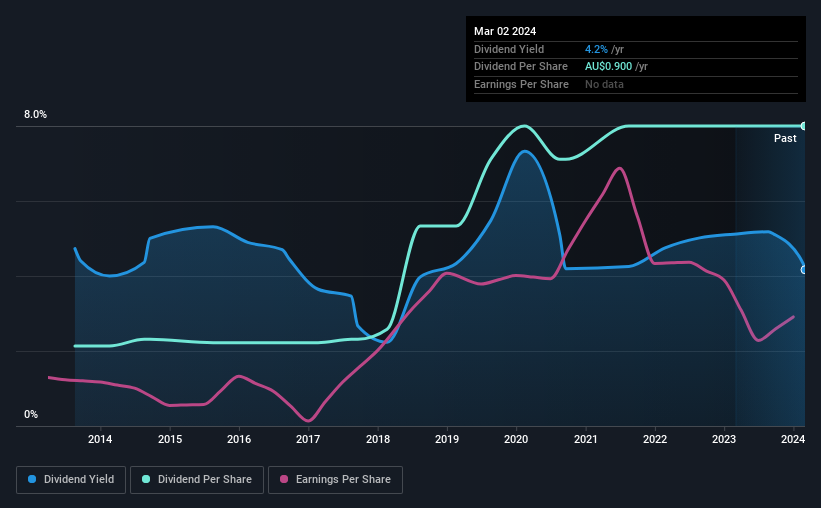Should Income Investors Look At Schaffer Corporation Limited (ASX:SFC) Before Its Ex-Dividend?
Schaffer Corporation Limited (ASX:SFC) stock is about to trade ex-dividend in four days. The ex-dividend date is one business day before the record date, which is the cut-off date for shareholders to be present on the company's books to be eligible for a dividend payment. The ex-dividend date is of consequence because whenever a stock is bought or sold, the trade takes at least two business day to settle. Accordingly, Schaffer investors that purchase the stock on or after the 7th of March will not receive the dividend, which will be paid on the 15th of March.
The company's upcoming dividend is AU$0.45 a share, following on from the last 12 months, when the company distributed a total of AU$0.90 per share to shareholders. Last year's total dividend payments show that Schaffer has a trailing yield of 4.2% on the current share price of AU$21.60. Dividends are an important source of income to many shareholders, but the health of the business is crucial to maintaining those dividends. That's why we should always check whether the dividend payments appear sustainable, and if the company is growing.
Check out our latest analysis for Schaffer
Dividends are typically paid out of company income, so if a company pays out more than it earned, its dividend is usually at a higher risk of being cut. Schaffer is paying out an acceptable 71% of its profit, a common payout level among most companies. Yet cash flows are even more important than profits for assessing a dividend, so we need to see if the company generated enough cash to pay its distribution. Thankfully its dividend payments took up just 38% of the free cash flow it generated, which is a comfortable payout ratio.
It's encouraging to see that the dividend is covered by both profit and cash flow. This generally suggests the dividend is sustainable, as long as earnings don't drop precipitously.
Click here to see how much of its profit Schaffer paid out over the last 12 months.
Have Earnings And Dividends Been Growing?
Stocks with flat earnings can still be attractive dividend payers, but it is important to be more conservative with your approach and demand a greater margin for safety when it comes to dividend sustainability. If earnings fall far enough, the company could be forced to cut its dividend. With that in mind, we're not enthused to see that Schaffer's earnings per share have remained effectively flat over the past five years. We'd take that over an earnings decline any day, but in the long run, the best dividend stocks all grow their earnings per share.
Many investors will assess a company's dividend performance by evaluating how much the dividend payments have changed over time. Schaffer has delivered 14% dividend growth per year on average over the past 10 years.
The Bottom Line
From a dividend perspective, should investors buy or avoid Schaffer? The payout ratios appear reasonably conservative, which implies the dividend may be somewhat sustainable. Still, with earnings basically flat, Schaffer doesn't stand out from a dividend perspective. To summarise, Schaffer looks okay on this analysis, although it doesn't appear a stand-out opportunity.
With that being said, if dividends aren't your biggest concern with Schaffer, you should know about the other risks facing this business. To that end, you should learn about the 3 warning signs we've spotted with Schaffer (including 1 which is a bit unpleasant).
Generally, we wouldn't recommend just buying the first dividend stock you see. Here's a curated list of interesting stocks that are strong dividend payers.
Have feedback on this article? Concerned about the content? Get in touch with us directly. Alternatively, email editorial-team (at) simplywallst.com.
This article by Simply Wall St is general in nature. We provide commentary based on historical data and analyst forecasts only using an unbiased methodology and our articles are not intended to be financial advice. It does not constitute a recommendation to buy or sell any stock, and does not take account of your objectives, or your financial situation. We aim to bring you long-term focused analysis driven by fundamental data. Note that our analysis may not factor in the latest price-sensitive company announcements or qualitative material. Simply Wall St has no position in any stocks mentioned.

 Yahoo Finance
Yahoo Finance 
